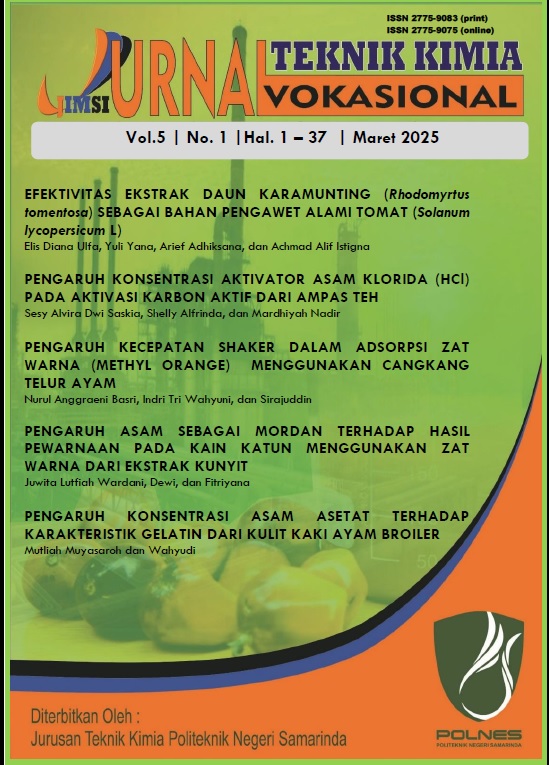PENGARUH ASAM SEBAGAI MORDAN TERHADAP HASIL PEWARNAAN PADA KAIN KATUN MENGGUNAKAN ZAT WARNA DARI EKSTRAK KUNYIT
 Abstract views: 18
,
Abstract views: 18
,
 pdf downloads: 22
pdf downloads: 22
Abstract
The increasing demand for natural dyes as an alternative to synthetic dyes, which can pollute the environment, has gained significant attention. Turmeric (Curcuma domestica Val) is commonly used as a natural dye source due to its curcuminoid content, which produces a yellow color. However, natural dyes tend to be less stable and more prone to fading, necessitating the use of a mordant as a binding agent to improve color fastness on fabric fibers. This study aims to examine the effect of using acidic mordants, specifically alum, ferrous sulfate (tunjung), and citric acid, on the dyeing results of cotton fabric using turmeric dye. The methodology involved a pre-mordanting process using alum, followed by a combination of post-mordanting treatments with alum, ferrous sulfate, and citric acid. Cotton fabric samples treated with alum and citric acid produced a bright yellow color, while samples treated with ferrous sulfate resulted in a brownish-yellow hue. The parameters tested included color depth (R%), color fastness to soap washing, and color fastness to staining on white fabric. The results indicated that cotton fabric treated with pre-mordanting using alum and turmeric dye achieved a color fastness rating of 4 (good) for soap washing, with a color depth value of 2.98. The combination of pre-mordanting and post-mordanting using alum as a mordant produced the highest color depth value of 7.03, along with good color fastness performance.
Copyright (c) 2025 JURNAL TEKNIK KIMIA VOKASIONAL (JIMSI)

This work is licensed under a Creative Commons Attribution-NonCommercial-ShareAlike 4.0 International License.
Copyright Transfer Statement
The copyright of this article is transferred to JIMSI and when the article is accepted for publication. the authors transfer all and all rights into and to paper including but not limited to all copyrights in the Psikostudia. The author represents and warrants that the original is the original and that he/she is the author of this paper unless the material is clearly identified as the original source, with notification of the permission of the copyright owner if necessary. The author states that he has the authority and authority to make and carry out this task.
The author states that:
- This paper has not been published in the same form elsewhere.
- This will not be submitted elsewhere for publication prior to acceptance/rejection by this Journal.
A Copyright permission is obtained for material published elsewhere and who require permission for this reproduction. Furthermore, I / We hereby transfer the unlimited publication rights of the above paper to Jurnal Teknik Kimia Vokasional. Copyright transfer includes exclusive rights to reproduce and distribute articles, including reprints, translations, photographic reproductions, microforms, electronic forms (offline, online), or other similar reproductions.
The author's mark is appropriate for and accepts responsibility for releasing this material on behalf of any and all coauthor. This Agreement shall be signed by at least one author who has obtained the consent of the co-author (s) if applicable. After the submission of this agreement is signed by the author concerned, the amendment of the author or in the order of the author listed shall not be accepted.
Rights / Terms and Conditions Saved
- The author keeps all proprietary rights in every process, procedure, or article creation described in Work.
- The author may reproduce or permit others to reproduce the work or derivative works for the author's personal use or for the use of the company, provided that the source and the Informatika Mulawarman copyright notice are indicated, the copy is not used in any way implying the Jurnal Psikostudia approval of the product or service from any company, and the copy itself is not offered for sale.
- Although authors are permitted to reuse all or part of the Works in other works, this does not include granting third-party requests to reprint, republish, or other types of reuse.
Jurnal Teknik Kimia Vokasional by http://e-journal.polnes.ac.id/index.php/jimsi licensed under a Creative Commons Attribution-ShareAlike 4.0 International License.








